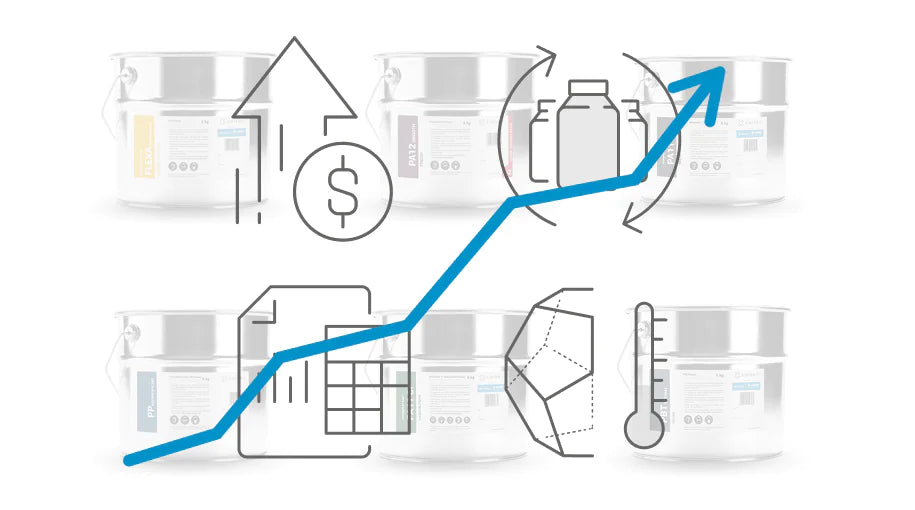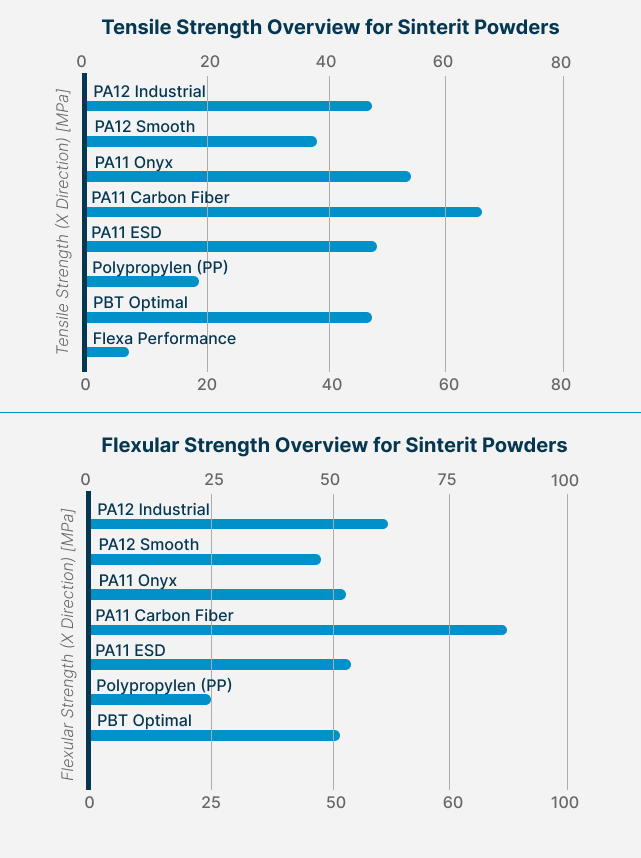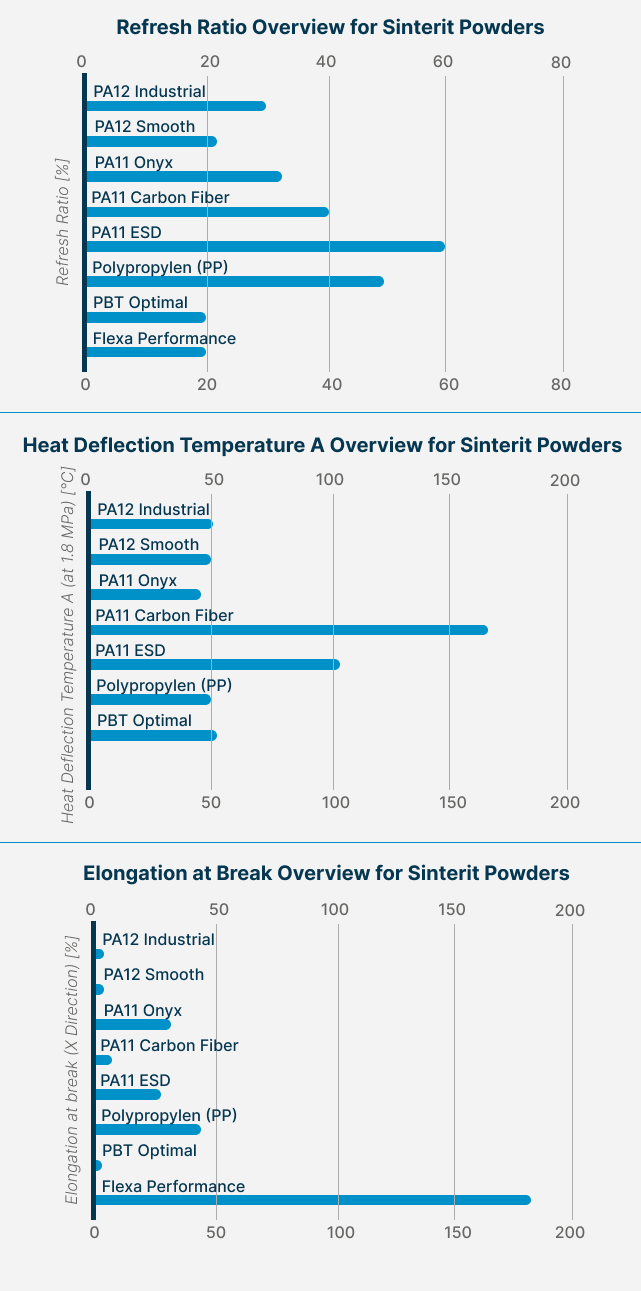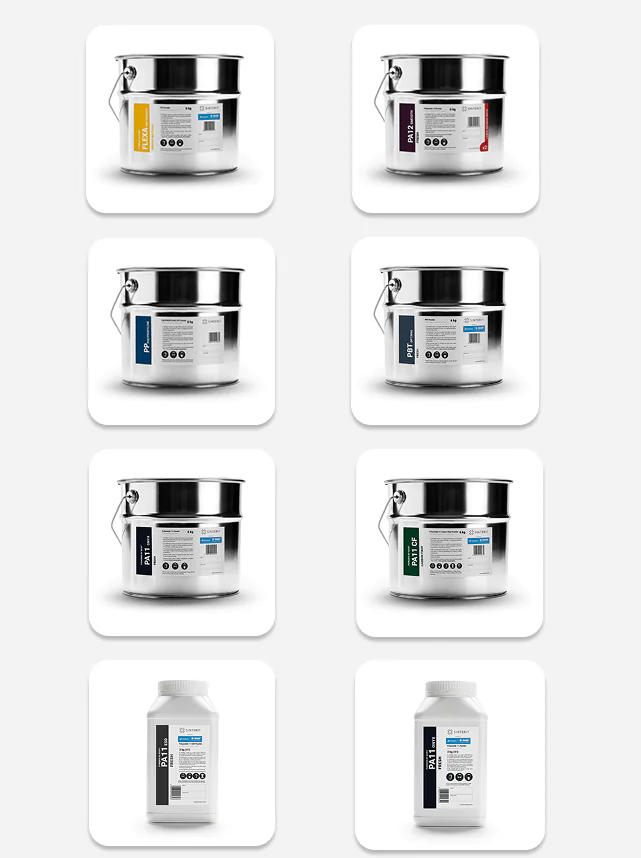Comparative Overview of Powder Material Properties for SLS Printing

| Powder | Tensile Strength (X) [MPa] | Flexural Strength (X) [MPa] | Elongation at Break (X) [%] | Heat Deflection Temp A (1.8 MPa) [°C] | Refresh Ratio [%] |
|---|---|---|---|---|---|
| PA12 Industrial | 47.61 | 62.31 | 5.86 | 51 | 30 |
| PA12 Smooth | 38.44 | 49.18 | 4.55 | 50 | 22 |
| PA11 Onyx | 55.00 | 54.20 | 31.60 | 47 | 33 |
| PA11 Carbon Fiber | 65.93 | 87.35 | 8.23 | 167 | 40 |
| PA11 ESD | 50.00 | 56.00 | 28.00 | 103 | 60 |
| Polypropylen (PP) | 19.30 | 25.60 | 44.40 | 50 | 50 |
| PBT Optimal | 49.04 | 52.08 | 2.56 | 52 | 20 |
| Flexa Performance | 7.99 | – | 182.63 | – | 20 |
Explanation of Key Technical Parameters
- Tensile Strength - Indicates the maximum stress a material can withstand when stretched before breaking. For the user, this shows how resistant to pulling or tension the printed part will be – crucial for clips, housings, and structural elements.
- Flexural Strength- Measures how much bending force a material can handle before failing. Important for slender or beam-like parts that may be bent or flexed in use.
- Elongation at Break- Tells you how much the material can stretch before it breaks – a measure of flexibility or ductility. A high value = flexible and impact-resistant parts. A low value = stiff and brittle.
- Heat Deflection Temperature A (HDT A)- This shows the temperature at which a material starts to deform under pressure. High HDT means the part is suitable for high-temperature environments, such as engine compartments or electronic housings.
- Refresh-Rate- Describes how much fresh powder needs to be added to used material to maintain print quality. Lower values = more cost-effective and sustainable powder usage.

Material Profiles and Use Cases
PA12 Industrial
Well-balanced mechanical performance. Great strength and moderate flexibility. Best for: functional prototypes, mechanical parts, everyday engineering applications.
PA12 Smooth
Slightly lower strength than Industrial, but with a lower refresh ratio. Great value for budget-conscious users. Best for: concept models, parts with fine surface details, general prototyping.
PA11 Onyx
High flexibility (31.6%) with solid strength. Strong but more forgiving than rigid fibers. Best for: snap fits, live hinges, parts requiring impact resistance.
PA11 Carbon Fiber
Top performer in all mechanical and thermal categories. Stiff, heat-resistant, and durable. Best for: end-use parts in engineering, automotive, motorsports, and industrial settings.
PA11 ESD
Balanced strength and high flexibility, plus ESD protection. Best for: electronic casings, enclosures, and ESD-safe tooling.
Polypropylene (PP)
Lower strength, but very flexible and chemically resistant. Best for: lightweight, chemical-exposed parts like tanks, tubes, or lab tools.
PBT Optimal
Rigid and precise, with low ductility. Best refresh ratio = economical for low packing density prints. Best for: technical precision parts, clips, electrical connectors.
Flexa Performance
Ultra-flexible, stretchable, and durable. Best for: seals, dampers, soft mechanisms, cushioning components.

Summary: SLS 3D Printing Powders Overview
Material Highlights by Key Performance Parameter:
Tensile Strength
PA11 Carbon Fiber (65.93 MPa) ➡ Offers the highest resistance to pulling forces – ideal for structural, load-bearing components.
Flexural Strength
PA11 Carbon Fiber (87.35 MPa) ➡ Delivers excellent resistance to bending – perfect for parts like brackets, frames, and housings.
Elongation at Break
Flexa Performance (182.63%) ➡ Extremely flexible – recommended for hinges, seals, and impact-absorbing elements. At the other end of the spectrum, PBT Optimal (2.56%) ➡ Remarkable stiffness for all applications requiring high rigidity.
Heat Deflection Temperature A (HDT A)
PA11 Carbon Fiber (167 °C) ➡ Withstands high temperatures – great for technical or automotive applications.
Refresh Ratio
PBT Optimal (20%) ➡ Most cost-efficient in powder reuse – ideal for economical prototyping workflows.

